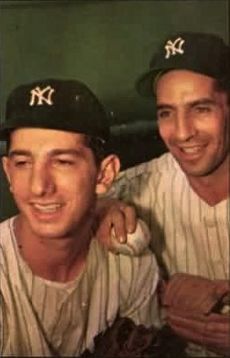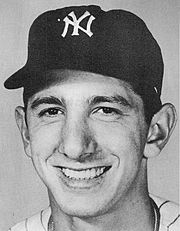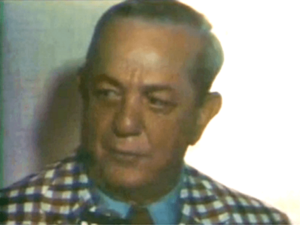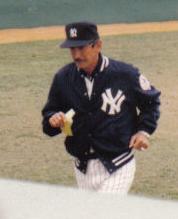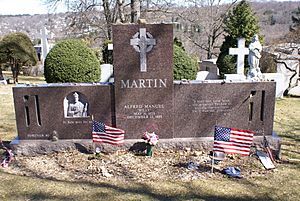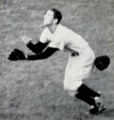Billy Martin facts for kids
Quick facts for kids Billy Martin |
|||
|---|---|---|---|
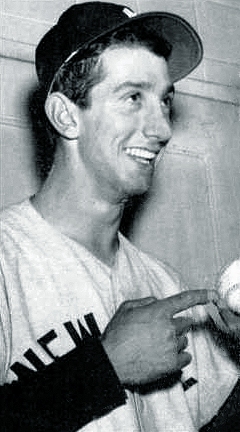
Martin with the Yankees in 1954
|
|||
| Second baseman / Manager | |||
| Born: May 16, 1928 Berkeley, California, U.S. |
|||
| Died: December 25, 1989 (aged 61) Johnson City, New York, U.S. |
|||
|
|||
| debut | |||
| April 18, 1950, for the New York Yankees | |||
| Last appearance | |||
| October 1, 1961, for the Minnesota Twins | |||
| MLB statistics | |||
| Batting average | .257 | ||
| Home runs | 64 | ||
| Runs batted in | 333 | ||
| Managerial record | 1,253–1,013 | ||
| Winning % | .553 | ||
| Teams | |||
As player
As manager
As coach
|
|||
| Career highlights and awards | |||
|
|||
Alfred Manuel Martin Jr. (May 16, 1928 – December 25, 1989), known as "Billy", was an American Major League Baseball player and manager. He played as a second baseman and managed several teams, including the New York Yankees five different times. Billy Martin was first known as a tough infielder who helped the Yankees win championships in the 1950s. Later, as a manager, he became famous for quickly improving struggling teams. However, he was often fired due to disagreements or team issues. In all his times with the Yankees, his teams had winning records before he was let go by owner George Steinbrenner or chose to resign.
Martin grew up in a working-class area of Berkeley, California. His talent in baseball offered him a way to a better life. He was signed by the Pacific Coast League Oakland Oaks. There, he learned a lot from Casey Stengel, who would also manage him in New York. Martin and Stengel had a very close relationship. In the 1952 World Series, Martin made an amazing catch of a fly ball hit by Jackie Robinson in Game Seven, which helped the Yankees win the series. He was also the star hitter in the 1953 World Series, winning the Most Valuable Player award as the Yankees won again. He missed parts of two seasons (1954 and 1955) because he was drafted into the Army. After his return, his playing skills were not quite the same. The Yankees traded him after an incident at a New York nightclub during the 1957 season. Martin was very upset about being traded and didn't speak to Stengel for many years. During this time, Martin played for several other teams before ending his career.
The last team Martin played for, the Minnesota Twins, offered him a job as a scout. He spent most of the 1960s with them, becoming a coach in 1965. After successfully managing the Twins' top minor league team, the Denver Bears, Martin became the Twins' manager in 1969. He led the team to win the American League West title, but was fired after the season. He then managed the Detroit Tigers starting in 1971, leading them to an American League East title in 1972. He was fired by the Tigers late in the 1973 season. Soon after, the Texas Rangers hired him. He turned them into a winning team in 1974, but was fired in 1975 due to conflicts with the team's owner. He was almost immediately hired by the Yankees.
As the Yankees' manager, Martin led the team to win the American League championship in 1976 and 1977. The Yankees lost the 1976 World Series to the Cincinnati Reds but won against the Los Angeles Dodgers in six games in the 1977 World Series. The 1977 season was full of tension between Martin and Steinbrenner, and also between Martin and Yankee star player Reggie Jackson. There was even a near fight between them in the dugout shown on national television. Despite the drama, the season ended with Martin's only World Series championship as a manager. He was forced to resign in the middle of the 1978 season after making a controversial comment about Jackson and Steinbrenner. Less than a week later, it was announced that he would return as manager in the future, which was met with huge cheers from the Yankee Stadium crowd. He returned in 1979, but Steinbrenner fired him again at the end of that season.
From 1980 to 1982, he managed the Oakland Athletics. He led them to a division title with an exciting style of play called "Billyball," which took them to the ALCS in 1981. However, he was fired after the 1982 season. The Yankees rehired him three more times, each for a season or less, and each time he was fired by Steinbrenner. Martin died in a car accident in upstate New York on Christmas night in 1989. Many Yankee fans remember him fondly.
Early Life and Baseball Dreams
Alfred Manuel Martin Jr. was born on May 16, 1928, in Berkeley, California. He was called "Billy" because his grandmother, who didn't speak much English, would often say bello (meaning "beautiful" in Italian) over him as a baby. Billy didn't know his real first name until a teacher used it at school. His parents separated when he was very young, and he didn't see his father again until he was in his thirties.
Billy Martin was not a great student in school. From about age 12, he often got into trouble with teachers. He was small for his age and grew up in a poor part of West Berkeley. Other kids sometimes made fun of him, which led to conflicts. He was very competitive and easily upset, quickly becoming known as a street fighter who would do anything to win.
Sports became a way for Martin to use his competitive energy. He boxed as an amateur, but baseball was his true calling. His older brother, Tudo, was friends with Augie Galan, a professional baseball player. Galan and other pros trained at James Kenney Park in Berkeley during the off-season. Billy would often go along with his brother. As Billy got older and played more, Galan took a special interest in teaching him about baseball.
When Martin attended Berkeley High School from 1942 to 1946, he stood out because he was dressed more simply than many other students. However, he gained acceptance through sports, especially baseball. His batting average improved greatly from .210 as a sophomore to an amazing .450 as a senior. He was an aggressive player and was involved in fights both on and off the field. One incident during his senior year led to him being removed from the team, which worried professional teams who were thinking of signing him. The Brooklyn Dodgers gave him a tryout, but they chose another California player, Jackie Robinson, instead.
The Oakland Oaks, a team in the Pacific Coast League, had been watching Martin for years. They were impressed with his skills but concerned about his temper. Soon after Martin graduated from high school, the Oaks' trainer, Red Adams, convinced the team's new manager, Casey Stengel, to give Martin a tryout. Stengel had seen Martin play before and told him he had a future in baseball. Within weeks, an infielder for the Oaks' minor league team was injured. Stengel suggested that the team owner sign Martin. The owner did, but tried to add a rule to the contract that would cancel it if Martin misbehaved like he had in high school.
Playing Career (1946–1961)
Starting in the Minors and Reaching the Majors
In 1946, 18-year-old Martin didn't play very well for the Idaho Falls team, hitting .254 and making many throwing errors. He had a good spring training with the Oaks in 1947 but was sent to a lower-level team, the Phoenix Senators. Martin felt he should have stayed with the Oaks and told Stengel this. The manager's reply was, "Prove me wrong."
Playing in tough conditions in the hot Southwest, Martin did very well. He wore uniform number 1, a number he always tried to get on every team. He hit .393, the highest average in baseball in 1947, and drove in 173 runs. He was named the league's most valuable player. When the team's regular second baseman was injured, Martin moved from third base to second base, where he played for most of his career.
When he wasn't playing, Martin closely watched Stengel, wanting to understand why the manager made certain decisions. This impressed Stengel, who had also tried to learn from his own manager when he was a player. Stengel and Martin became very close, almost like a father and son.
Martin made the Oaks' main roster in 1948. Stengel had him sit on the bench next to him, pointing out important details of the game. Martin also learned from his teammates. He finished the season with a .277 batting average. He became a team leader, often involved in on-field arguments and known for shouting at opposing teams. The Oaks won their league championship. Martin was sad when Stengel left to manage the New York Yankees, as Martin had always dreamed of being a Yankee.
Stengel's replacement with the Oaks was Charlie Dressen. Dressen was very knowledgeable about baseball. He was first cautious of Martin because he was a Stengel favorite, but Martin's hard work and desire to learn won him over. Martin continued to improve his skills, learning things like how to steal signs from the opposing team. In 1949, Martin improved his statistics, hitting .286 with 12 home runs. Stengel, who was managing the Yankees to a championship, often talked about Martin to the New York press, making it seem like Martin would soon join the Yankees. On October 13, 1949, the Yankees acquired Martin.
Becoming a Yankee Star (1950–1957)
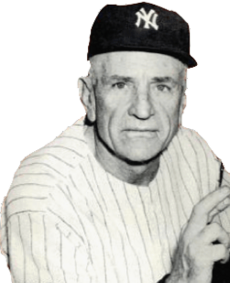
When Martin joined the Yankees, some news reports called him just a "utility infielder." He was part of a group of young Yankees, including Whitey Ford, Yogi Berra, and Mickey Mantle, who trained early under Stengel. Martin hoped to be the starting second baseman for the Yankees, but the current player, Jerry Coleman, had just won an award. Martin made his major league debut on April 18, 1950. He doubled and singled in the same inning, driving in four runs. This was the first time a player got two hits in an inning in his first game. Despite this, Martin wasn't an everyday player at first, but he quickly became a favorite of the Yankee Stadium crowd.
Martin was sent to the minor leagues for a month in May 1950, which he strongly disagreed with. He believed this upset the team's front office. He returned to the Yankees but played little. The Yankees won the championship in 1950, but Martin did not play in the 1950 World Series. After the season, he was drafted into the army during the Korean War but received an early release. He rejoined the Yankees in late April 1951 but was used sparingly. Martin helped rookie Mickey Mantle feel more comfortable in New York. In the 1951 World Series, which the Yankees won, Martin scored a crucial run as a pinch runner.
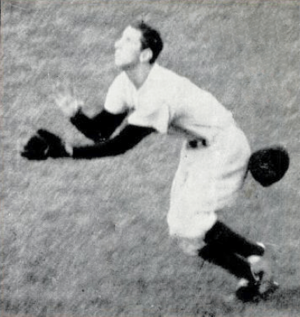
When Jerry Coleman joined the armed forces before the 1952 season, Martin became the Yankees' regular second baseman. His debut was delayed by an ankle injury, but once he started playing, he hit .267 and became a key player for Stengel's team. In the 1952 World Series against the Dodgers, Martin hit a three-run home run in Game Two. In Game Seven, with the Yankees leading 4–2, Jackie Robinson hit a high fly ball. Martin raced in from second base and made a spectacular catch near home plate, saving the game and possibly the series for the Yankees. This catch is considered one of the greatest moments in World Series history.
In 1953, Martin played 149 games, hitting .257 with 15 home runs and 75 runs batted in, all career highs. He was ejected from games twice that year for arguing and fighting. Opposing players often slid hard into second base, trying to injure him. Despite this, he was one of the best second basemen in the league for fielding. The Yankees won their fifth straight championship. In the 1953 World Series, Martin was outstanding, getting 12 hits and breaking Babe Ruth's record for total bases. His hit in the ninth inning of Game Six scored the winning run. He was named the Series' Most Valuable Player. Stengel praised him, saying, "He doesn’t look like a great player—but he is a helluva player. Try to find something he can't do. You can't."
In early 1954, Martin was drafted into the army again and missed the entire 1954 season, which was the only year the Yankees didn't win the championship during his time there. He also missed much of the 1955 season. He played on and managed the baseball team at Fort Carson in Colorado. In August 1955, he returned to the Yankees. Although he hit well, the Yankees lost the 1955 World Series to the Dodgers. He was discharged from the army later that October.
During the 1956 season, the Yankees' general manager, George Weiss, hinted to the media that Martin was a bad influence on other players, especially his roommate, Mantle. Weiss wanted a more dignified image for the Yankees. By 1956, the Yankees had new young infielders coming up, like Bobby Richardson. Weiss wanted to trade Martin, but he was very popular with fans and the press. Martin played in the 1956 All-Star Game, his only All-Star appearance as a player. His playing skills were not quite the same after his time in the army. He hit .264 with nine home runs in 1956. In the 1956 World Series against the Dodgers, Martin played well, helping the Yankees win in seven games. He finished his World Series playing career with a .333 batting average.
Weiss warned Martin to stay out of trouble before the 1957 season. An incident at the Copacabana nightclub in New York on May 16 gave Weiss the reason he needed to trade Martin. Although another Yankee player was accused of starting a fight, Martin believed Weiss would blame him. As the trade deadline approached, Martin was worried. On June 15, 1957, Martin was traded to the Kansas City A's. He was very upset and felt abandoned by Stengel, rarely speaking to him for years afterward. This trade marked the beginning of Martin's time as a player moving from team to team.
Playing for Other Teams (1957–1961)
After being traded to the A's, Martin played well in his first game against the Yankees. However, the A's were a struggling team. Martin hit .257 with Kansas City. At the end of the season, Martin was traded to the Detroit Tigers in a large 13-player deal. He was angry, saying, "They just can’t throw us [players] around from one club to another without us having a say-so."
Detroit manager Jack Tighe called Martin "the key to our future." But without the strong talent of the Yankees or Stengel's support, Martin couldn't turn the Tigers into a winning team. He played shortstop, but he wasn't very good at it and made 20 errors. He hit .255 with seven home runs. After the season, Martin was traded to Cleveland.
With Martin at second base, the Indians finished second in 1959. In August, Martin was hit on the head by a pitch, breaking a bone in his face. This made him afraid of being hit again, which affected his hitting. He was traded after the season to the Cincinnati Reds. Martin was still a fighter on the field. In 1960, he got into a famous fight with pitcher Jim Brewer of the Chicago Cubs. Martin was ejected and suspended for five games. The Cubs sued Martin, and the case was settled years later.
Although Martin played 103 games for the Reds in 1960, his hitting skills were declining. After the season, he was sold to the Milwaukee Braves. His old manager from the Oaks, Dressen, was with the Braves, but couldn't find a starting spot for Martin. On June 1, 1961, he was traded to the Minnesota Twins. Martin started well with the Twins but then had a long hitting slump. He batted .242 for 1961, his lowest full-season average. In 1962, he was released by the Twins. At 33 years old, Martin's playing career was over.
Scout, Coach, and Minor League Manager (1962–1968)
After his playing career ended, Martin accepted an offer from Twins owner Calvin Griffith to be a scout for the team. He also worked in public relations for a brewery. Martin proved to be good at finding talented players. He suggested the Twins sign pitcher Jim Palmer, but the team didn't want to pay the signing bonus Palmer asked for. Palmer went on to have a Hall of Fame career with another team. During this time, Martin stayed out of trouble and kept his drinking under control.
In 1965, Griffith made Martin the third base coach for the Twins. This led to talk that Martin would become manager if the team struggled. The Twins had a great season in 1965, winning the American League championship. Martin worked with the players to make them more aggressive on the bases. He helped young players like Rod Carew improve. He also worked with shortstop Zoilo Versalles, who was later voted the league's Most Valuable Player. Even though the Twins lost the 1965 World Series, Martin was given a lot of credit for their success.
In 1966, Martin got into a fight with the Twins' traveling secretary, which hurt his chances of becoming manager. When the Twins' manager was fired in 1967, Martin was not chosen as the replacement.
The Twins started the 1968 season poorly. Martin was offered the job as manager of the Denver Bears, the Twins' top minor league team. He was hesitant at first, but his wife convinced him he needed to prove himself as a manager. The Bears had a losing record when Martin took over, but by the end of the season, they had a winning record. Martin taught the team to play aggressively and focus on the basics. He was tough on his players when they lost, making them afraid to lose. He also defended them fiercely against umpires, getting ejected from eight games. By the end of the season, many people thought Martin would be a major league manager in 1969. On October 11, 1968, the Twins gave Martin a one-year contract as manager.
Managing Career
Minnesota Twins (1969)
As the Twins' manager, Martin continued his aggressive style of baseball. The team started with four losses but then won many games in April, taking first place in the new American League West. Martin made it clear that he would do anything to win. In one game, after Oakland A's slugger Reggie Jackson hit two home runs, a Twins pitcher threw a pitch close to Jackson's head, leading to a big fight. Jackson later blamed Martin for ordering the pitches.
Despite the team's success, owner Griffith was not happy with Martin's behavior. Martin often showed up late for meetings with Griffith. In August, Martin got into a fight with pitcher Dave Boswell outside a bar. Martin claimed Boswell attacked him first. Even though Boswell was fined, Griffith thought about firing Martin. However, the team was winning, so he kept him. The Twins won their division by 9 games.
In the 1969 American League Championship Series (ALCS), the Twins played the Orioles, who had won more games during the regular season. Baltimore won the first two games. For Game Three, Martin chose a different pitcher instead of his star pitcher, Jim Kaat. The Twins lost Game Three and were eliminated.
Martin had a one-year contract for 1969 and asked for a two-year deal for 1970 and 1971. Griffith was unhappy with Martin's pitching choice and his explanation. Other events, like the fight with Boswell and Martin kicking a former US vice president out of the locker room, also embarrassed the team. Twins executives felt Martin caused too much trouble. On October 13, 1969, Griffith fired Martin. Many Twins fans were angry, and team attendance dropped in 1970.
Detroit Tigers (1971–1973)
Martin spent 1970 out of baseball. In October 1970, the Detroit Tigers hired him as manager. The Tigers had won the 1968 World Series but had struggled since. General manager Jim Campbell believed Martin was the spark the team needed.
Martin announced that the Tigers would win in 1971. He made it clear he would run the team his way. His angry speeches to players, even in spring training, were reported in the news. He had a public disagreement with star player Willie Horton, whom Martin often benched. Martin also argued with umpires and other team staff. After a slow start, the Tigers won seven games in a row. Martin's managing skills were praised, but the team finished second in their division. Still, Martin led the Tigers to a 91–71 record, a big improvement from 1970.
Martin received a new two-year contract. The 1972 season started late due to a player strike. Martin continued his usual behavior, arguing with opposing managers and umpires. The AL East pennant race was very close. The Tigers won their division in the final games of the season.
In the 1972 American League Championship Series, the Tigers played the Oakland A's. In Game Two, a Tigers pitcher hit an A's player, leading to a fight. Many believed Martin had ordered the pitch. The Tigers came back from a 2–0 deficit to tie the series but lost Game Five. Martin was praised for leading the Tigers so far. He received another contract extension.
The 1973 season was not as successful for Martin and the Tigers. Martin wanted Campbell to trade older players for new ones, but Campbell refused. Martin briefly quit during spring training over a fine he had given Horton. Conflicts within the team grew as they fell behind in the standings. Martin angered team owners by criticizing the front office in the media.
On August 30, Martin ordered his pitchers to throw illegal pitches because he believed the opposing pitcher was doing so without being called out. He told the media what he had done and was suspended. This was the final straw for Campbell, who fired Martin before the suspension ended.
Texas Rangers (1973–1975)
Texas Rangers owner Bob Short knew and trusted Martin. After Martin was fired by the Tigers, Short quickly hired him, firing his own manager to do so.
Martin faced a big challenge with the Rangers, who were a very bad team. He felt Short understood him and was given a five-year contract that made him both manager and general manager, giving him full control over the team. Most of the players admired Martin from watching him as a Yankee.
In the winter of 1973–1974, Martin made several trades, bringing in key pitchers. He also promoted young players from the minor leagues. Just before the 1974 season, Short sold the team, and the new owner kept Martin as manager but took away his control over the roster.
The Rangers started the season against the champion A's. Martin said it would be a battle between the top two teams, even though experts thought the Rangers had little chance. The Rangers played well and were in first place by the end of April. Martin taught the Rangers to play better and to fear his anger. One player said Martin made the team afraid to lose.
The Rangers stayed close to the division lead through May and June. They finished second, a huge improvement from 1973. Martin was named AL Manager of the Year, and fan attendance more than doubled.
Expectations were high for the Rangers in 1975. However, the team did not play as well. Relations between Martin and the Rangers' front office became tense due to Martin's behavior and conflicts with some players. Martin reportedly hit the team's traveling secretary. In July, after an argument with the owner, Martin told the media that the owner "knows as much about baseball as I do about pipe." The owner fired Martin the next day, July 20.
First Time with the Yankees (1975–1978)
1975 and 1976 Seasons
Martin was not out of work for long. Two weeks after Texas fired him, the Yankees fired their manager. Martin was hired to take his place, returning to the Yankees for the first time since 1957. Yankees owner George Steinbrenner and general manager Gabe Paul knew about Martin's past behavior. They put good-conduct rules in his contract and chose his coaching staff.
With little chance of winning in 1975, Martin spent the rest of the season evaluating his team. Steinbrenner had been suspended from baseball but still made decisions behind the scenes, like hiring Martin. With Martin as manager, the Yankees improved their record.
Martin worked with Paul to trade some players and bring in new ones like Mickey Rivers and Willie Randolph. The 1976 Yankee season was one of his smoothest as a manager. Martin quickly won over his players. Steinbrenner returned to managing the Yankees during spring training but did not interfere with Martin, content to watch the team win.
The Yankees won their division by 11 games, making their first postseason appearance since 1964. In the 1976 American League Championship Series, they played Kansas City. Aggressive base running and shouting from the dugout helped New York win Game One. Martin's choice of pitcher for the deciding Game Five was questioned, but the Yankees won. In the ninth inning, Yankee first baseman Chris Chambliss hit a home run to win the game and the Yankees' first championship since 1964. The Yankees then faced the defending champion Reds in the 1976 World Series and lost in four straight games. Martin was ejected from Game Four for throwing a baseball towards an umpire.
1977 Championship Season
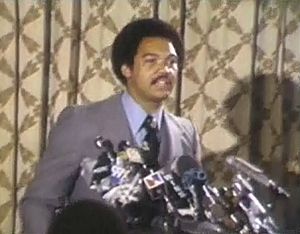
In the offseason, Steinbrenner wanted to sign star player Reggie Jackson. Jackson signed with the Yankees, even though New York didn't offer the most money. There are different stories about how Martin felt about Jackson joining the team. Some say he wasn't against it, while others say he didn't want Jackson because he thought Jackson would be difficult to manage. Martin was upset that Steinbrenner took Jackson to fancy restaurants but didn't invite him.
When the Yankees lost six of their first eight games in 1977, Steinbrenner told Martin to turn things around or he would be fired. In May, Jackson upset his teammates by saying in an interview that he, not team captain Thurman Munson, was the most important player on the team.
Tensions between Martin and Jackson exploded on national television on June 18. Martin pulled Jackson off the field mid-inning for not running hard on a fly ball. An enraged Martin had to be held back by coaches from fighting Jackson in the dugout. Steinbrenner wanted to fire Martin, but a truce was made. However, rumors that Martin would be fired continued all season. The public supported Martin, so Steinbrenner kept him. The team was winning and getting a lot of attention in the newspapers.
By August 7, there was more conflict on the team, and the Yankees were five games behind. Martin had promised to bat Jackson fourth, but rarely did. After other players talked to Martin, he batted Jackson fourth on August 10, and both Jackson and the team started playing much better. Despite a season of turmoil, the Yankees won 40 of their last 50 games to win the division. Martin looked exhausted from the stressful season.
The Yankees played the Royals again in the 1977 American League Championship Series. The teams split the first two games, and the Royals won Game Three. Needing to win two straight games on the road, the Yankees won Game Four. Martin benched Jackson from the starting lineup in Game Five, believing he didn't hit the Royals' pitcher well. In the eighth inning, with the Yankees losing, Martin put Jackson in as a pinch hitter. Jackson singled to drive in a run. The Yankees scored three runs in the ninth to win their second straight championship.
The 1977 World Series was against the Los Angeles Dodgers. The Yankees won Game One. They lost Game Two, and there was more conflict between Martin and Jackson in the news. A meeting helped smooth things over. The Yankees won Games Three and Four but lost Game Five. Before Game Six, the Yankees announced that Martin was getting a bonus and a longer contract, which eased some of the pressure on him. Jackson, who had been jokingly called Mr. October by Munson, earned the name by hitting three home runs in a row off three different Dodger pitchers. The Yankees won 8–4, and the crowd celebrated by rushing onto the field. Jackson and Martin were interviewed together, with their arms around each other. This was Martin's only World Series championship as a manager, and it was a very difficult one.
1978 and First Departure
The events of 1977 made Martin one of the most famous people in New York. He was often seen in the city's nightlife. He also got many endorsement deals but didn't pay taxes on them, leading to problems with the tax authorities for the rest of his life. The Yankees' general manager, Gabe Paul, left after the 1977 season, which removed someone who helped keep peace between Martin and Steinbrenner.
The 1978 season started with more conflict. Steinbrenner blamed Martin for not keeping discipline. Martin didn't believe in trying to control players' behavior off the field. Injuries to several players meant the Yankees didn't start the season well. By mid-June, they were seven games behind. Martin was under extreme stress all summer due to constant rumors that he would be fired.
By July 17, the Yankees were 13 games behind. That day, in a game against the Royals, Jackson failed to follow a bunt sign. Martin was furious and wanted Jackson suspended. Martin also learned that Steinbrenner had been trying to trade managers with another team. Martin then made a controversial comment about Jackson and Steinbrenner.
The next day, July 24, 1978, Martin announced he was stepping down for health reasons at a press conference. He did this on the advice of his lawyer, who believed the Yankees would fire him. By resigning for health reasons, Martin made sure Steinbrenner had to honor his contract. Steinbrenner replaced Martin with Bob Lemon. Many Yankee fans were angry about Martin's departure and at Steinbrenner.
Billy II: Second Time with the Yankees (1979)
Steinbrenner quickly had second thoughts about Martin leaving. Negotiations for his return began within two days. The plan was for Martin to return in 1979. The talks were kept secret. On Old-Timers' Day at Yankee Stadium on July 29, 1978, Martin was introduced as the Yankees manager for 1980 and beyond. The crowd gave him a huge cheer.
The re-hiring was a verbal promise and depended on Martin staying out of trouble, which he didn't always do. During the offseason, Martin got into a fight with a reporter. Steinbrenner said Martin could only return if there was no conviction or settlement, and this happened. Meanwhile, the Yankees, under Lemon, made a dramatic comeback to win the championship in 1978.
In 1979, the Yankees started slowly under Lemon. Injuries and players not performing well led Steinbrenner to fire Lemon on June 18 and bring Martin back. The Yankees didn't improve much, and the team was devastated by Thurman Munson's death in a plane crash on August 2. The Yankees finished in fourth place. After the season, Martin got into a fight with a marshmallow salesman in a hotel. Facing pressure from the baseball commissioner, Steinbrenner fired Martin five days later.
Oakland Athletics (1980–1982)
Martin didn't get any immediate job offers after being fired by the Yankees. But in February 1980, Oakland A's owner Charlie Finley wanted to hire him. The A's had been struggling and had very low fan attendance. Finley hoped Martin could revive the team. Martin knew this might be his last chance to manage.
The 1980 A's had few famous players, but many young players looked up to Martin. Some who later became stars said Martin helped them develop. He taught Rickey Henderson how to steal bases effectively. Many people in baseball were surprised when the A's were close to first place by the end of May. The A's finished second in their division, a 29-game improvement, earning Martin a Manager of the Year award. Fan attendance also increased greatly.
The new owners of the A's gave Martin more power, making him in charge of all baseball operations. Martin's aggressive style of play was called "Billyball" by a sportswriter in 1981, and the name stuck. The A's started the 1981 season incredibly well. Martin appeared on the cover of Time magazine. His five starting pitchers were very good, throwing many complete games because Martin didn't trust his relief pitchers. Martin was praised by fans across the country, even when he was ejected from a game and suspended for kicking dirt on an umpire. The season was interrupted by a player strike. The A's won their division and played the Yankees in the championship series. Martin really wanted to beat the Yankees. However, the Yankees swept the series in three games.
Expectations were high for the A's in 1982. However, the season did not go well. None of the starting pitchers matched their 1981 performance, and some baseball experts believe Martin overworked them in 1981, shortening their careers. The A's finished with their worst full-season record under Martin.
On October 20, 1982, three weeks after the season ended, the A's fired him. The owners were worried about his behavior off the field, including drinking and traveling with a mistress. The final straw came when Martin damaged his office after team officials refused him a loan to pay a tax debt. Some people believe Martin was trying to get fired so he could return to the Yankees.
More Times with the Yankees
The Yankees had a losing record in 1982 under three different managers, all fired by Steinbrenner. On January 11, 1983, the Yankees announced that Martin had been hired as manager again. Steinbrenner promised not to interfere, but when the team struggled early, he started criticizing Martin. Martin also had conflicts with reporters and a fight in a bar.
During the 1983 season, Martin was involved in a famous game known as the Pine Tar Incident. Martin argued that a home run by George Brett was illegal because of too much pine tar on his bat. The umpires first ruled Brett out, but the league president later overturned the decision. The game was resumed weeks later. The Yankees didn't play as well after this distraction and finished second in their division. On December 16, Steinbrenner removed Martin as manager, giving him a scouting job and replacing him with Yogi Berra.
The Yankees finished third under Berra in 1984. At the start of the 1985 season, Steinbrenner promised Berra would stay manager all season, but many thought Martin would return. Steinbrenner fired Berra after 16 games and replaced him with Martin. Martin said, "George and I have the greatest relationship I've ever had with him." With strong play from Don Mattingly and Rickey Henderson, the team played well. However, they lost many games in a row in September. On September 22, 1985, Martin fought one of his pitchers, Ed Whitson, in a hotel bar and broke his arm. The Yankees won 97 games but finished two games behind. On October 27, 1985, Martin was fired again and replaced by Lou Piniella. However, Steinbrenner still paid Martin a high salary, fearing he might manage another team to a championship.
Steinbrenner kept Martin as a close advisor in 1986. Martin had long wanted his number 1 retired by the Yankees. Steinbrenner agreed, and Billy Martin Day took place at Yankee Stadium on August 10, 1986. At the ceremony, his number was retired, and he received a plaque in Monument Park. He said, "I may not have been the greatest Yankee to ever put on the uniform but I was the proudest."
New York finished second in 1986 and fourth in 1987. After the 1987 season, Piniella became general manager so Steinbrenner could make Martin manager for a fifth time in 1988. Martin got the 1988 Yankees off to a good start. However, on May 7, Martin was involved in another fight at a nightclub. On May 30, Martin was ejected from a game for throwing dirt on an umpire and was suspended. A month later, Steinbrenner fired Martin again. Martin became a special advisor to Steinbrenner but rarely visited New York.
Piniella returned as manager but was fired at the end of the 1988 season. Steinbrenner replaced him with Dallas Green. The Yankees didn't do well under Green in 1989, and he was fired in August. Steinbrenner planned to keep Martin ready to manage again in 1990.
Death
Martin was still a special consultant to Steinbrenner when he died in a car accident on Christmas Day 1989. His vehicle crashed near the entrance of his farm in Port Crane, New York. He was pronounced dead at a hospital in Johnson City, New York.
Martin's funeral was held at St. Patrick's Cathedral, New York. He was buried at Gate of Heaven Cemetery in Hawthorne, New York, near Babe Ruth's grave. The words on his headstone are from his number retirement ceremony: "I may not have been the greatest Yankee to put on the uniform, but I was the proudest." Steinbrenner and former President Richard Nixon, along with many New York Yankee legends, attended his funeral.
Managerial Record
| Team | Year | Regular season | Postseason | |||||||
|---|---|---|---|---|---|---|---|---|---|---|
| Games | Won | Lost | Win % | Finish | Won | Lost | Win % | Result | ||
| MIN | 1969 | 162 | 97 | 65 | .599 | 1st in AL West | 0 | 3 | .000 | Lost ALCS (BAL) |
| MIN total | 162 | 97 | 65 | .599 | 0 | 3 | .000 | |||
| DET | 1971 | 162 | 91 | 71 | .562 | 2nd in AL East | – | – | – | – |
| DET | 1972 | 156 | 86 | 70 | .551 | 1st in AL East | 2 | 3 | .400 | Lost ALCS (OAK) |
| DET | 1973 | 134 | 71 | 63 | .530 | fired | – | – | – | – |
| DET total | 452 | 248 | 204 | .549 | 2 | 3 | .400 | |||
| TEX | 1973 | 23 | 9 | 14 | .391 | 6th in AL West | – | – | – | – |
| TEX | 1974 | 160 | 84 | 76 | .525 | 2nd in AL West | – | – | – | – |
| TEX | 1975 | 95 | 44 | 51 | .463 | fired | – | – | – | – |
| TEX total | 278 | 137 | 141 | .493 | 0 | 0 | – | |||
| NYY | 1975 | 56 | 30 | 26 | .536 | 3rd in AL East | – | – | – | – |
| NYY | 1976 | 159 | 97 | 62 | .610 | 1st in AL East | 3 | 6 | .333 | Lost World Series (CIN) |
| NYY | 1977 | 162 | 100 | 62 | .617 | 1st in AL East | 7 | 4 | .636 | Won World Series (LAD) |
| NYY | 1978 | 94 | 52 | 42 | .553 | fired | – | – | – | – |
| NYY | 1979 | 95 | 55 | 40 | .579 | 4th in AL East | – | – | – | – |
| OAK | 1980 | 162 | 83 | 79 | .512 | 2nd in AL West | – | – | – | – |
| OAK | 1981 | 60 | 37 | 23 | .617 | 1st in AL West | 3 | 3 | .500 | Lost ALCS (NYY) |
| 49 | 27 | 22 | .551 | 2nd in AL West | ||||||
| OAK | 1982 | 162 | 68 | 94 | .420 | 5th in AL West | – | – | – | – |
| OAK total | 433 | 215 | 218 | .497 | 3 | 3 | .500 | |||
| NYY | 1983 | 162 | 91 | 71 | .562 | 3rd in AL East | – | – | – | – |
| NYY | 1985 | 145 | 91 | 54 | .628 | 2nd in AL East | – | – | – | – |
| NYY | 1988 | 68 | 40 | 28 | .588 | fired | – | – | – | – |
| NYY total | 941 | 556 | 385 | .591 | 10 | 10 | .500 | |||
| Total | 2266 | 1253 | 1013 | .553 | 15 | 19 | .441 | |||
Managerial Style and Legacy
 |
|
| Billy Martin's number 1 was retired by the New York Yankees in 1986. |
Baseball experts often noted that Billy Martin's teams usually improved a lot in his first year as manager. However, within a year or two, those teams were often ready to let him go. This was partly because Martin would do whatever it took to win that day, without worrying about future negative effects on players. For example, some believe he overworked his young pitchers on the 1981 A's, which shortened their careers.
In 1988, a sports statistics group called Elias Sports Bureau said Martin was the best manager in baseball history. They found that his teams won more games than expected based on statistics. He was the first manager to lead four different teams to the postseason. Martin tried to surprise other teams with tactics like stealing home. He even had two Twins players steal home on different pitches in the same at-bat. This tactic is very risky, but Martin made it work, and his teams got better.
Many people, including his boss George Steinbrenner, thought Martin was a baseball genius because of his natural understanding of the game. Hall of Fame manager Tony La Russa called Billy "the most brilliant field manager I ever saw." Casey Stengel, Martin's former manager, said Martin was a "good manager" and that he "never let you down in the clutch."
Martin wanted to win, no matter what. He once said he would play anyone on his team if he thought it would help him win. Players like Willie Randolph said that if they were in a close game in the late innings, Billy would find a way to win. Martin's reputation for being tough and controversial has kept him out of the Hall of Fame, according to some experts.
Personal Life and Public Image
Billy Martin was married four times and had two children, a daughter named Kelly Ann and a son named Billy Joe.
Martin and Steinbrenner appeared together in popular TV commercials for Miller Lite beer. In one commercial filmed in 1978, Steinbrenner "fires" Martin, who says, "Oh, not again." This commercial aired again in 1979 after Martin returned to manage the Yankees, but with Steinbrenner saying, "You're hired."
In 1978, Martin played himself in a TV movie called One in a Million: The Ron LeFlore Story. Martin was also a guest ring announcer at the first WrestleMania event in March 1985.
In 1978, Martin and a sports agent opened a western wear store in New York City called Billy Martin's. The store stayed open until 2010.
Images for kids
-
Casey Stengel in 1953
-
Martin's game-saving catch of Jackie Robinson's popup in Game 7 of the 1952 World Series
-
Reggie Jackson at the press conference announcing his signing with the Yankees, 1976
-
Martin (center) with pitcher Catfish Hunter and Brad Gulden during a 1979 game soon after Thurman Munson's death
See also
 In Spanish: Billy Martin (béisbol) para niños
In Spanish: Billy Martin (béisbol) para niños


